The distance between Mercury and the Sun is not constant. It varies greatly depending on the different positions of the planet along its orbit as it elongates.
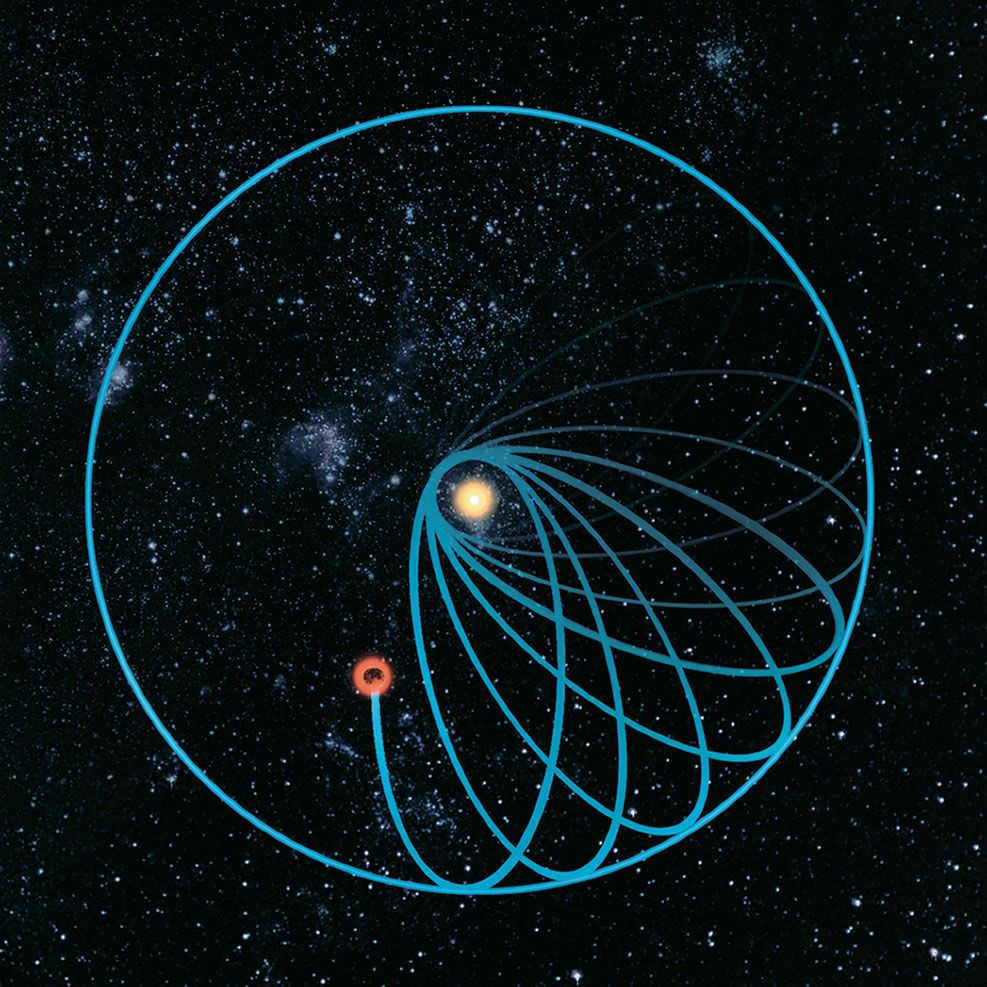
Mercury’s orbit around the Sun has a duration of approximately 88 days on Earth. Credit: rutlib4.com
General information about the planet
Mercury is one of the celestial bodies visible in the sky without the need for astronomical equipment. The exact date of its discovery is unknown, but it occurred long before the beginning of our era. The planet got its name from the Roman god of trade, who was known for his swift movements. This is because Mercury moves rapidly across the celestial sphere.
Here are some important characteristics of the planet:
- Average diameter: 4.88 thousand kilometers
- Circumference at the equator: 15.33 thousand kilometers
- Average density: 5.43 g/cm³
- The acceleration of free fall on Mercury is 3.7 m/s² (this value is observed at the equator);
- The period of rotation around its axis is 58.5 Earth days;
- Mercury does not have any natural satellites.
Mercury possesses a mass of 33.33022⋅10²³ kg. Approximately 40% of its solid composition (some sources suggest up to 80%) is occupied by a molten iron core. Above this core lies a silicate mantle, which measures 500-700 km in thickness. The surface crust, on the other hand, is 100-300 km thick. This unique structure of the planet can be explained by the fact that it was initially much larger. Over time, only the main body of the planet remained, while the outer layers collapsed. This event may have occurred as a result of a collision with a large object or due to the influence of solar heating.
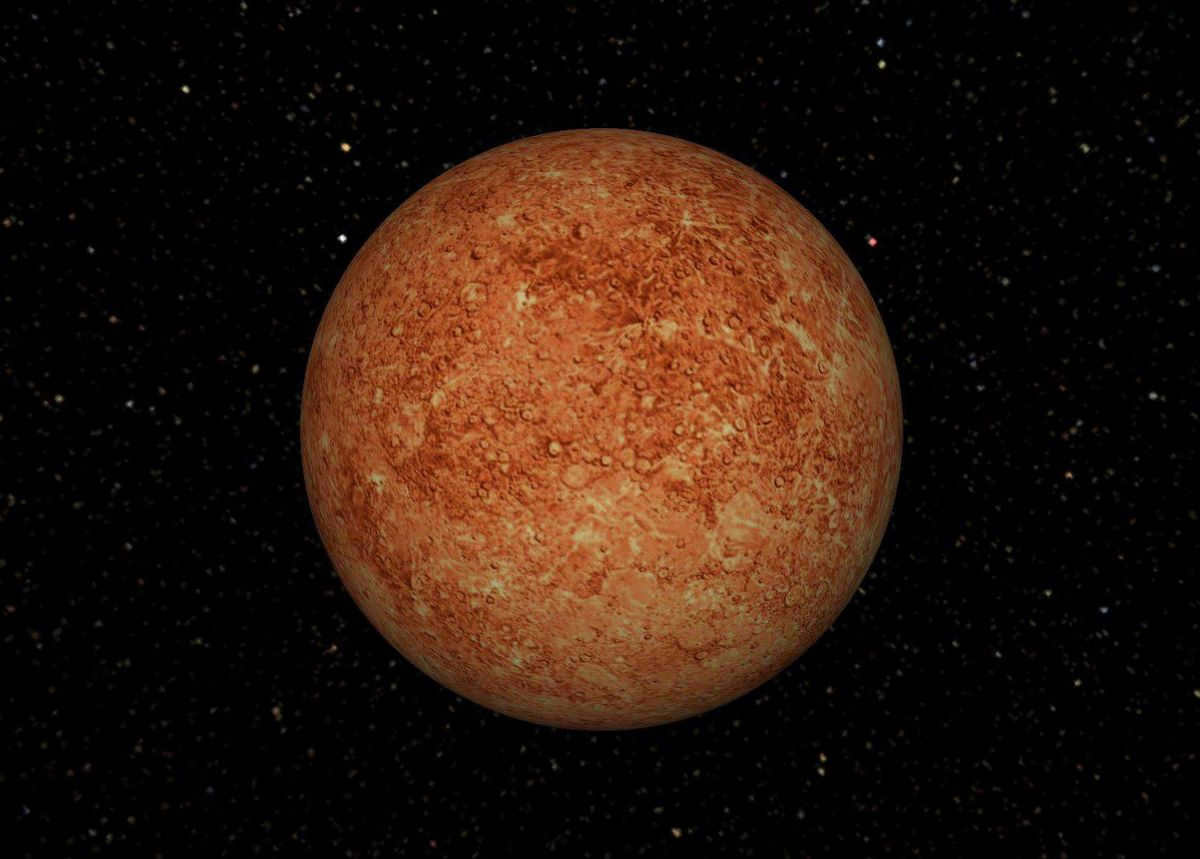
The surface of Mercury is extensively covered with craters. Over the course of its existence (approximately 4.6 billion years), the planet has endured countless impacts from asteroids and space debris. The absence of an atmosphere has allowed these celestial bodies to collide with the surface of Mercury, leaving distinctive marks. Simultaneously, internal tectonic activity has contributed to the creation of vast plains and towering mountains.
Unlike other celestial bodies with atmospheres, Mercury does not retain solar heat. As a result, the temperatures on the planet vary drastically, ranging from +427 °C on the side facing the sun to -173 °C on the side facing away from it.
Only two spacecraft, Mariner 10 and Messenger, have been used to study this planet. Mariner 10 conducted research from 1974 to 1975, while Messenger operated from 2011 to 2015. In late 2025, the BepiColombo research station, which was launched in 2018, will approach the planet. It is expected to remain in Mercurian orbit for a minimum of one year, during which it will have the opportunity to:
- Analyze the surface composition;
- Evaluate the geological history of the celestial body;
- Investigate the local magnetic field;
- Create detailed maps of the object.
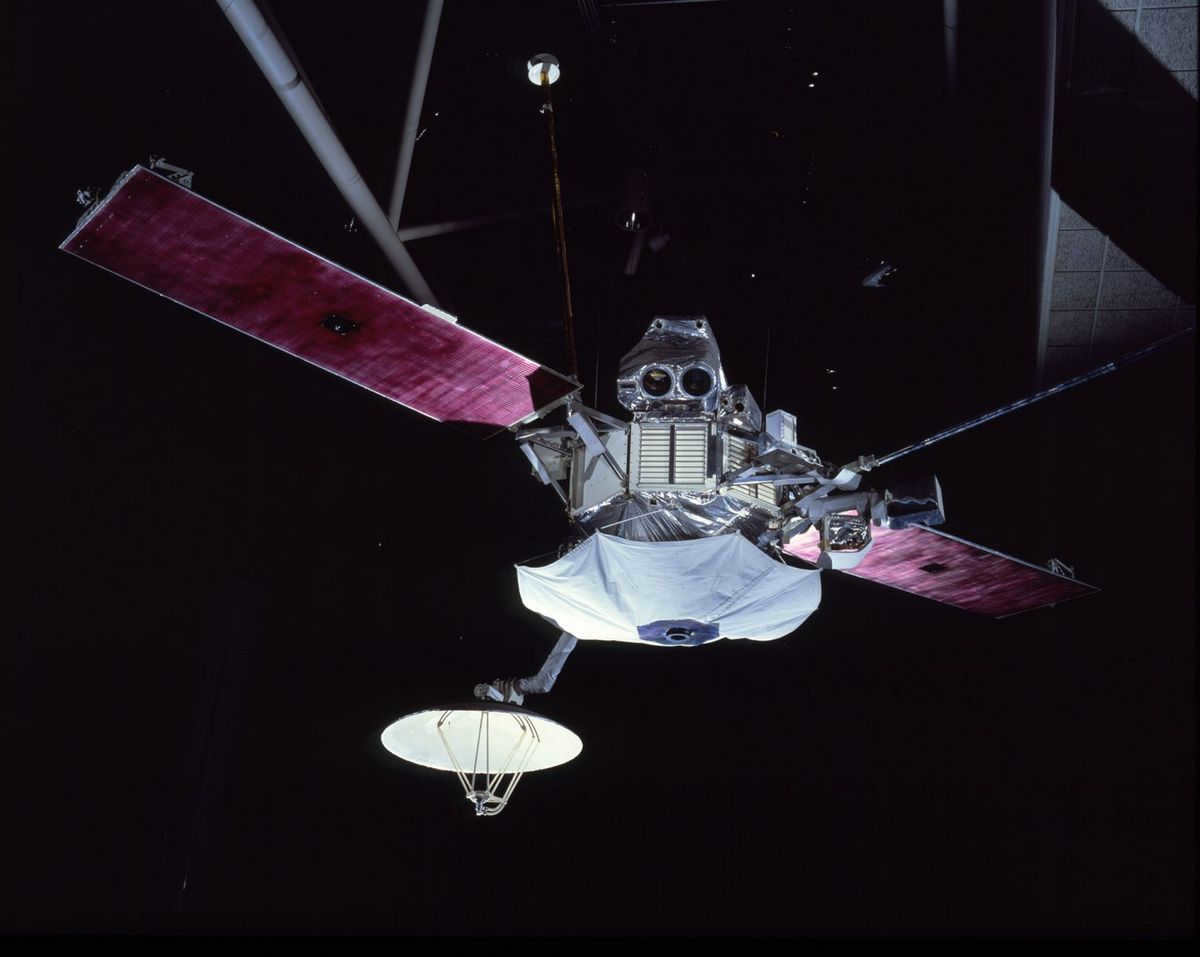
Mercury’s path around the Sun
The planet follows a curved path around the Sun, covering a distance of 47.4 kilometers per second and completing one full orbit around the star in 88 Earth days. The orbit of Mercury is tilted at an angle of 7° with respect to the plane of the Earth’s orbit around the Sun.
Mercury, being situated in a unique position, shares its space with only one neighboring planet, Venus.
Distance from the Sun
The distance from Mercury to the Sun (57.9 million km) is not constant. The significant elongation of the planet’s orbit causes this value to decrease to 45.9 million km at perihelion and increase to 69.7 million km at aphelion.
This variation in distance can be attributed to the distinctive elongation of Mercury’s orbit. With an eccentricity (compression coefficient) of 0.2, it holds the highest value among all the planets in our solar system. This high orbital eccentricity of Mercury means that it can only be observed during times when it is at its farthest distance from the Sun, as it would otherwise be overshadowed by the luminous star.
Venus Distance
When Venus and Earth approach their closest point to each other, the gap between their orbits measures 50.3 million kilometers. This distance is slightly greater than the shortest distance between Earth and Venus. When Mercury and the second planet of the Solar System are at their farthest point from each other, the distance between them reaches 166 million kilometers.
The distance from Earth to Mercury, along with the distance between any two celestial bodies in space, is calculated in astronomical units. This value corresponds to the semi-major axis of Earth’s orbit, which is equal to 149.6 million kilometers.
Mercury’s position in the solar system
There are 8 planets in the solar system. The one closest to the Sun is Mercury. Along with Venus, Earth, and Mars, these 4 celestial bodies make up the Earth group. They are different from the giants (Jupiter, Saturn, Uranus, and Neptune) in terms of their high density and composition, which consists mainly of iron and silicates.
Each of these celestial bodies revolves around the Sun at a specific speed, which decreases as they move farther away from the star. Mercury travels at a speed of 47.36 km/sec, Earth moves at 29.76 km/sec, and Neptune, being the farthest, moves at a leisurely pace of 5.48 km/sec.
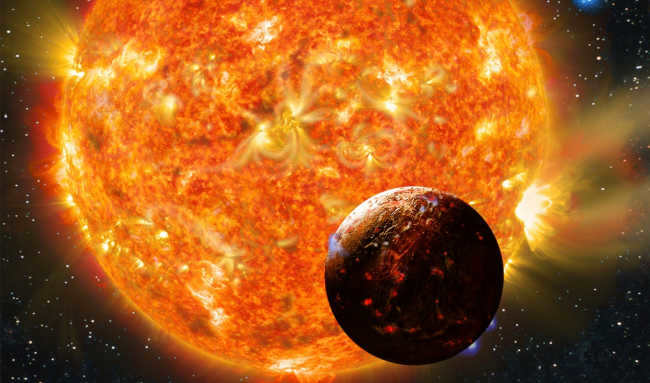
Mercury revolves around its axis at a slow pace, completing a full rotation in 58,646 Earth days. Venus, on the other hand, has a longer rotation period of 243 days. However, Mercury manages to orbit the Sun in just 87.97 days. This means that a year on Mercury is equivalent to approximately 1.5 Earth days, making it 4.148 times faster than on our planet.
Since Pluto’s demotion from planet status in 2006, Mercury has held the title of the smallest planet in the solar system. It has a mass of 3.302*10²³ kg, which is only 0.055 times the weight of Earth. The equatorial and polar radii of Mercury are the same, measuring 2440 kilometers.
The objects that fall on the surface of Mercury move at a much slower speed compared to Earth. This is because Mercury has no atmosphere, which is influenced by solar winds and extreme temperatures ranging from -180°C to +430°C.
Mercury can be observed in the sky during clear mornings before sunrise in the east and during evenings just after sunset in the west. It can be seen within 28° of the Sun, above the horizon. In temperate regions of Russia and other countries in the northern hemisphere, this planet is visible from January to April in the evening and from July to October in the early morning. The opposite is true in the southern hemisphere.
Mercury appears orange in color, which is a result of the reflected rays passing through the dense layers of Earth’s atmosphere.
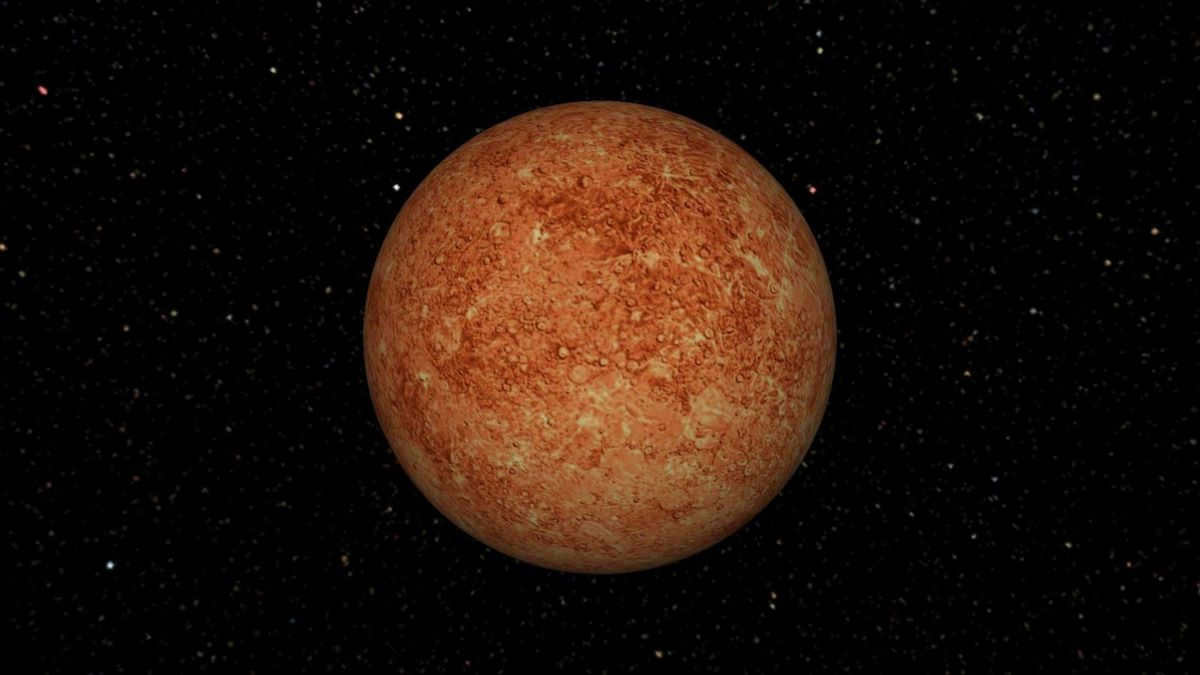
The transit of Mercury across the sun’s disk is a rare phenomenon that astronomers seldom get the chance to observe. This event was initially documented by Pierre Gassendi in 1631. Even rarer than the transit of Mercury is the alignment of both Mercury and Venus along the sun’s disk, which was first witnessed by the Englishman John Bavis. The next occurrence of this remarkable event is not expected until the year 2133.
All planets orbit along an elliptical path with different parameters. Astronomers refer to the closest distance between the celestial body and the Sun as perihelion, and the farthest distance as aphelion.
When discussing a single value, we can consider the average distance, which is 0.387 astronomical units (a.u.) or 57.91 million kilometers for Mercury.
The values for the minimum and maximum distances are as follows:
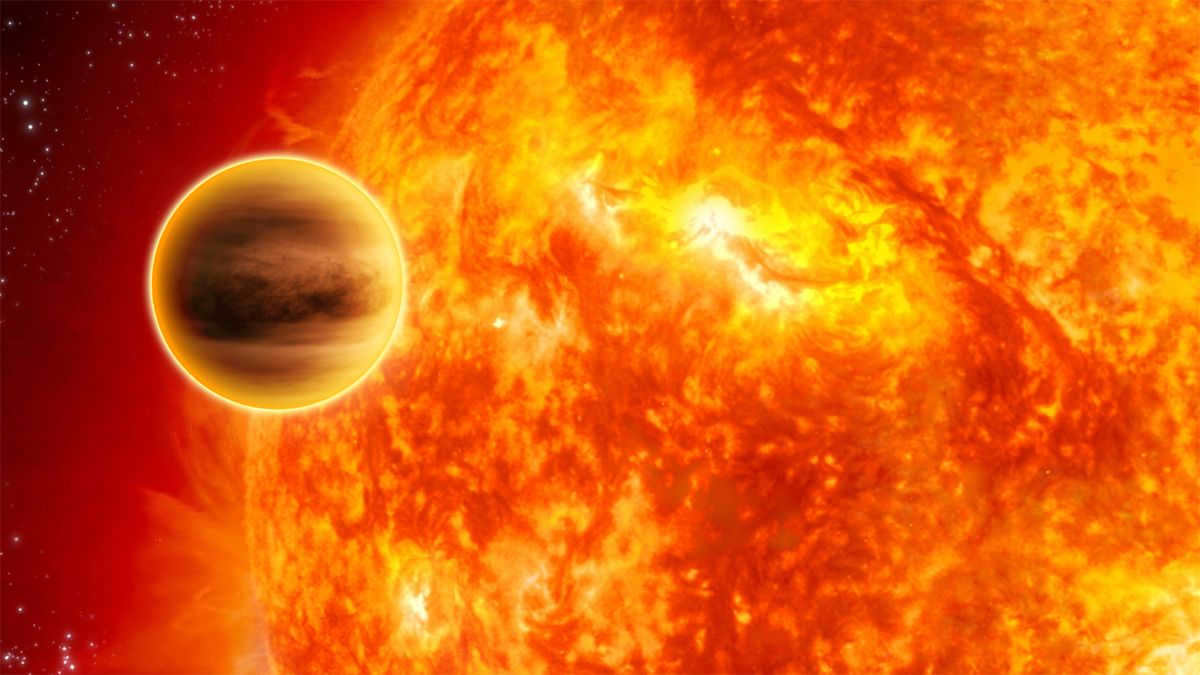
The distance between Mercury and the Sun is quite significant, primarily due to the high value of eccentricity, which reflects the extent to which the shape of the orbit deviates from a perfect circle. With a value of 0.205636, Mercury has the largest eccentricity among all the planets in the Solar System. The only exception is Pluto, which, since 2006, no longer falls under the official definition of a planet.
Earth’s Distance
The closest distance between celestial bodies occurs when their orbits intersect, measuring 82.2 million kilometers or 0.549465 astronomical units (a.u.). This event happens periodically, within a range of 105 to 129 days. It has been observed that the minimum distance gradually decreases over time. On average, every 116 days, Mercury gets closer to Earth by about 53 kilometers. Based on calculations, it is estimated that in 27 thousand years, the distance will reach a minimum of 0.5347759 a.u., after which the planets will start moving apart.
At its aphelion, when the Sun is positioned between Mercury and Earth, the greatest distance between them is 217 million kilometers.
What is the duration of a flight to Mercury?
In the foreseeable future, it is estimated that it would take approximately 4 and a half minutes to reach Mercury if spaceships capable of traveling at the speed of light are developed. However, it is important to note that such advanced spacecrafts have not been created yet.
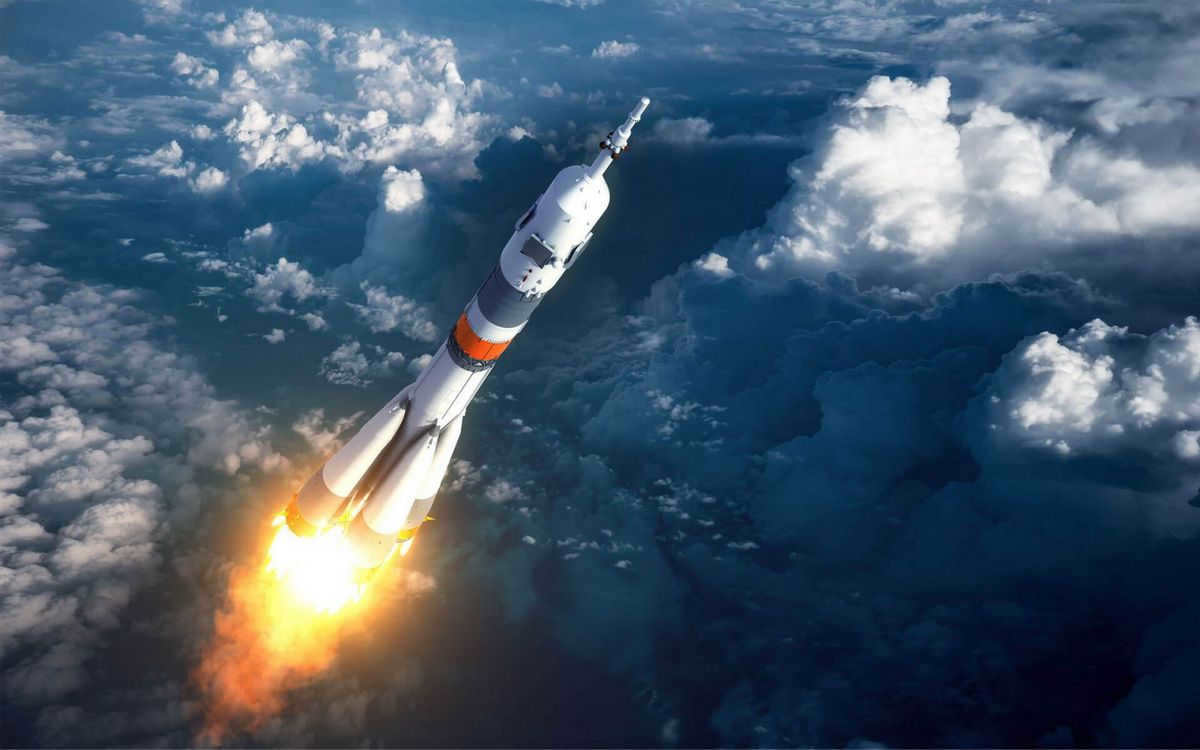
The intricacy of the flight is a result of the powerful pull of the Sun. Consequently, specific gravitational maneuvers were executed. Initially, the spacecraft was decelerated in order to enter a highly elliptical orbit. And once the spacecraft approached Mercury, the probe received the momentum to follow the orbital trajectory. Given the feeble gravity of Mercury, a substantial amount of fuel was necessary to execute the maneuver. As a result, only 2 vehicles explored the planet.
In November 1973, an interplanetary automated station named Mariner-10 was launched to Mercury for the first time. Taking into consideration the maneuvers, the journey lasted for 147 days.
The second spacecraft, named “Messenger”, was launched on August 3, 2004. In 2008, after 1260 days, the probe completed its first orbit around Mercury. By 2011, through the use of gravitational maneuvers, the spacecraft became an artificial satellite of the planet. In 2015, “Messenger” impacted Mercury, creating a crater.
In October 2018, the BepiColombo mission was initiated from the spaceport in French Guiana. This mission is expected to last until 2025, covering a distance of 9 billion kilometers. The spacecraft utilizes ion engines for propulsion and will require numerous gravitational maneuvers throughout its journey.
The mission’s objectives include investigating the composition and characteristics of the magnetic field, as well as studying the previously identified ice. The scientists aim to gain insights into the processes involved in the formation and development of planets near the star, while also testing specific hypotheses related to the theory of relativity.
Mercury’s position in the solar system
Following the reclassification of Pluto by the International Astronomical Union as a minor planet within the Kuiper belt, Mercury now holds the title of the smallest major celestial body in the solar system.
- Mercury’s mass is 18 times smaller than that of Earth, and its volume is nearly 17.8 times smaller. The speed of Mercury ranges from 38.7 to 56.6 km/s, depending on its orbital position.
- A year on Mercury, the smallest planet in the solar system, lasts only 88 Earth days, during which it completes a full revolution around the sun.
- One sidereal day on Mercury lasts almost two-thirds of its year, while a solar day is twice as long. It rotates on its axis 59 times slower than Earth.
Distance from the Sun
The distances separating celestial objects are typically measured in astronomical units (AU). An astronomical unit is equivalent to the average distance between the Earth and the Sun, which is approximately 149.6 million kilometers.
When considering the inner planets’ distances from the center of a planetary system, it is worth noting that these measurements are also given in astronomical units:
Mercury’s distance from the Sun is not a fixed value. On average, it is around 57,910,006 kilometers. However, due to its elliptical orbit, this value can vary significantly. At its closest point to the Sun, the distance decreases to approximately 45.9 million kilometers, while at its furthest point, it reaches about 69.7 million kilometers.
The average distances from the center of the planetary system to the nearest planets are as follows:
- Mercury – approximately 57.9 million kilometers.
- Venus – approximately 108 million kilometers.
- Earth – approximately 150 million kilometers.
- Mars – approximately 228 million kilometers.
To calculate the difference in distance between Earth and the Sun compared to Mercury, you can consult the following table:
| Planet | Mercury | Venus | Earth | Mars |
| Distance in km | 57 910 006 | 108 199 995 | 149 599 951 | 227 939 920 |
| Distance in sv. years | 0.0000061 | 0.0000114 | 0.0000158 | 0.0000240 |
Distance from Earth
In our solar system, all the planets revolve around the Sun in elliptical orbits with varying degrees of eccentricity. Additionally, each planet has a different speed of rotation.
During opposition, when the Sun is positioned between the Earth and Mercury, the planet reaches its farthest distance from Earth, which is approximately 217 million kilometers. This occurs when Mercury is in the aphelion of its orbit, meaning it is one and a half times farther from the Sun compared to its perihelion.
Although Venus is the closest planet to Earth on average, Mercury frequently comes closer to our planet due to its higher speed of movement. Approximately every 116 Earth days, Mercury reaches its minimum distance from Earth, which is the same distance it is from the Sun.
The distance between Mercury and Earth, which is only 82.2 million kilometers, is observed when the orbits of celestial bodies converge. This distance is not fixed and gradually decreases due to the motion of the Earth. Approximately every 600 years, the distance is reduced by 100,000 km. Preliminary estimates suggest that the maximum convergence will be 80 million km, which will not occur until 29,012. After that, the planets will start moving away from each other again.
Distance to Venus
The proximity of the orbits of Mercury and Venus is nearly identical to the mean distance separating Earth and Venus. In the event that the planets align at aphelion, their proximity will shrink to a mere 50.3 million kilometers. Conversely, at their farthest separation, this distance will expand to approximately 166 million kilometers.
Mercury has a very thin atmosphere, which offers little protection from cooling and allows most of the infrared rays to be reflected. As a result, Venus, which is further away from the heat source, is actually hotter than Mercury. This is due to the fact that Venus’ atmosphere is composed of 96.5% carbon dioxide, creating a dense cloud cover that prevents the scattering of infrared rays. The greenhouse effect caused by this atmosphere leads to a consistent temperature of around +464 degrees Celsius across the entire surface of the planet. In contrast, Mercury, despite being closer to the heat source, cools down to -173 degrees Celsius on its “night” side and heats up to +427 degrees Celsius on its “day” side.
Exploration of Mercury
Studies have revealed that Mercury holds promise for future colonization. However, due to the considerable travel time required to reach the planet and establish an Earth-based expedition, this endeavor is unlikely to occur within the next two decades. The primary challenges that impede manned missions to Mercury include high levels of radiation, drastic temperature variations on the planet’s surface, and the necessity of transporting substantial quantities of resources from Earth. As of now, there are no reliable long-term safeguards in place to protect astronauts from these detrimental factors, necessitating the remote exploration of Mercury.
First flight – Mariner mission
The Mariner mission, an American interplanetary station, departed from Cape Canaveral on November 3, 1973. While the main objective was to study the planet Mercury, a significant portion of its resources were dedicated to flying over and photographing the atmosphere of our closest celestial neighbor, coming within a distance of 5,770 km.
Throughout the journey, the speed of the space probe experienced fluctuations. After leaving the Moon’s orbit, the Mariner-10 accelerated to a speed of 38,600 km/h. It took nearly three months for the 500 kg automatic research station to reach Venus. By utilizing Venus’ gravitational pull, the probe executed a maneuver to alter its flight trajectory. This adjustment allowed for a reduction in excessive speed, bringing it down to approximately 16,000 km/h. Otherwise, if it had continued to travel at such a high velocity, the spacecraft risked overshooting its target due to the immense gravitational influence exerted by the Sun.
In early 1974, the research vehicle successfully entered a heliocentric orbit. Over the course of 11.5 months, it had the opportunity to make three close approaches to Mercury, with the minimum distance being only 327 kilometers. Unfortunately, by 1975, the probe had run out of fuel for course corrections and could no longer respond to signals from the control center. However, it remained in orbit as an artificial satellite, now positioned in a heliostationary orbit.
The second space mission was called Messenger
This automated spacecraft was launched from Earth on August 3, 2004. It had a weight of 1.1 tons and was equipped with rotating solar panels, a protective shield, one undercarriage, and 16 maneuvering rocket engines. The fuel required for the flight was more than 600 kg, which accounted for over 50% of the total weight.
It took the Messenger spacecraft 7 years to travel from Earth to its destination. During this time, the spacecraft had to perform 6 gravity maneuvers to slow down and synchronize its orbit. Due to its large weight, the spacecraft needed a higher initial velocity to overcome the pull of Earth’s gravity. In the near-Earth orbit, the velocity was 30 km/s, while near the destination it decreased to 5.4 km/s. After making three passes at an altitude of 200 km, the spacecraft entered a stable orbit and transmitted clear images to TsUP for almost a year.
Third flight – BepiColombo mission
Astronomers are filled with optimism regarding the flyby module which was launched on October 20, 2018. This module will transport two independent instruments to explore the magnetosphere, surface composition, and surrounding space of the diminutive celestial body, following in the footsteps of previous missions.
The spacecraft in orbit will require approximately 7 years to journey from Earth to Mercury. Its anticipated arrival in orbit is in 2025.
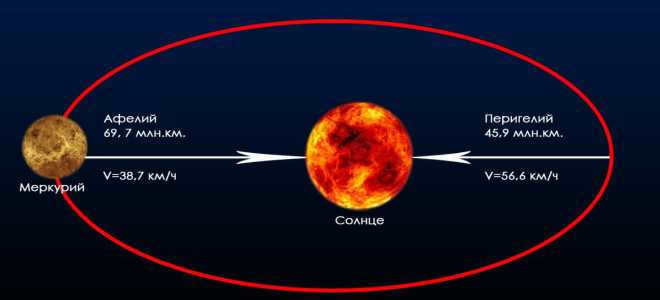
The name Mercury was given to the planet that is situated closer to the Sun than any other planet in our solar system, about 700 years before the current era.
Due to its visibility without the need for specialized instruments or tools, Mercury has been studied since ancient times. It has been mentioned in myths, legends, and tales. The earliest records of Mercury can be found in the Moul Apin tablet, which documented the astronomical and astrological phenomena of the Babylonians.
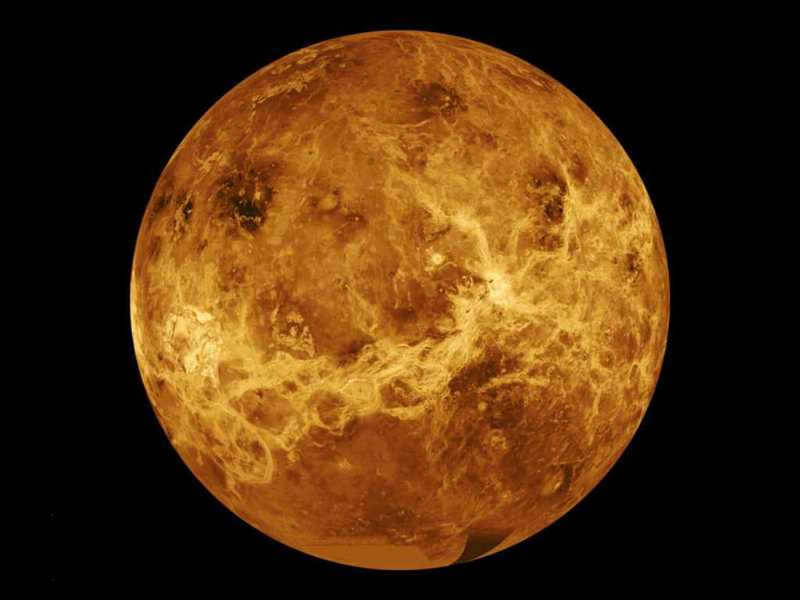
The planet Mercury received its name in ancient Rome, where it was worshipped as one of the main deities and considered a patron of travelers and traders. Historians believe that knowledge about the planet’s existence dates back to prehistoric times.
In ancient Greece, Mercury was known by two names. It was referred to as Apollo in the morning and Hermes in the evening. This dual naming occurred because the Greeks were unaware that they were observing the same planet.
Mercury is one of the five planets that were discovered without the aid of astronomical equipment.
With a diameter of approximately 4,879 kilometers, Mercury bears a resemblance to the moon.
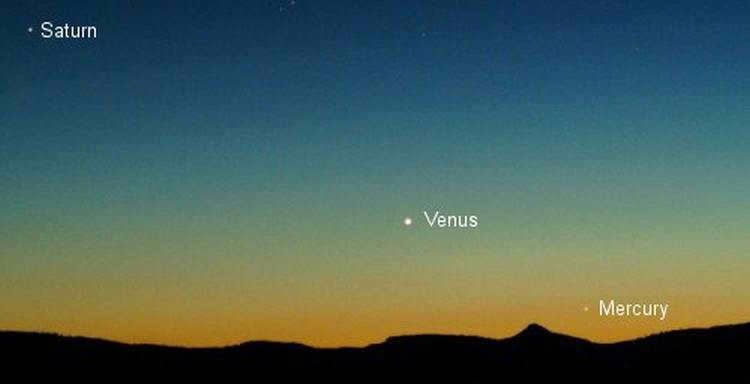
Merkury is known as one of the most scorching planets in the solar system, with the day side reaching a staggering 427 degrees Celsius. However, as soon as the sun sets on this fiery planet, the temperature plummets to a bone-chilling -173 degrees Celsius. The absence of a protective atmosphere means that Merkury cannot maintain a stable temperature, resulting in dramatic fluctuations.
Mercury’s rotation differs significantly from Earth’s. While it rotates slowly around its axis, its orbital period is relatively short.
It takes 116 Earth days for Mercury to complete one revolution around its axis. Every 116 days, it also comes closer to Earth. The orbital period, which is the time it takes for Mercury to make a full revolution around the Sun or a year on Mercury, is 88 days. In comparison, Earth completes four circles around the Sun in one year.
Before 1962, it was believed that Mercury had a synchronous rotation, meaning it always kept the same side facing the Sun. However, in 1962, researchers using observatories discovered that Mercury has a clear period of circulation, known as a Mercurian day, which lasts for 59 days.
When Mercury approaches aphelion, its orbital motion speeds up and reaches 149% of its angular velocity.
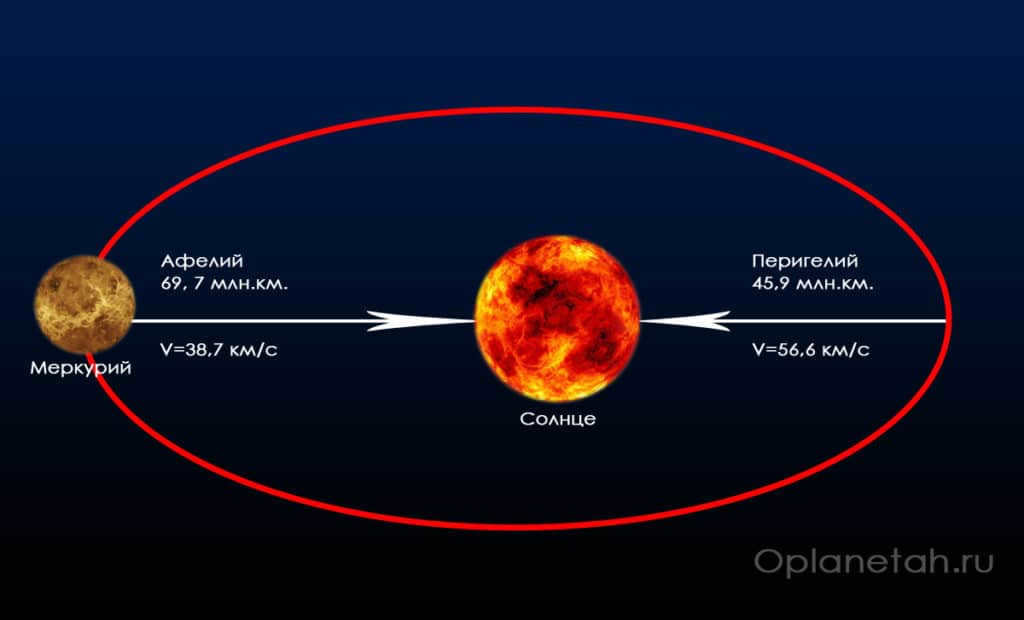
As Mercury approaches its closest distance to the Sun, the Sun’s motion relative to the planet gradually decelerates until it comes to a complete stop. However, it then resumes its movement, initially at a slow pace and then progressively accelerates. This change in motion across the sky also affects the apparent size of the Sun, causing it to either shrink or expand depending on the distance between Mercury and the Sun.
Scientific studies and experiments have revealed that a day on Mercury comprises a significant portion (2/3) of its year. Similarly, the synodic (outer) orbital period of the planet Mercury is also approximately two-thirds of its 24-hour day. Remarkably, this ratio holds true for all the planets in our solar system.
During perihelion, the combination of internal and external rotation leads to an increase in the planet’s speed. This planet is unique in that it completes nearly a full orbit around the Sun within our observable space.
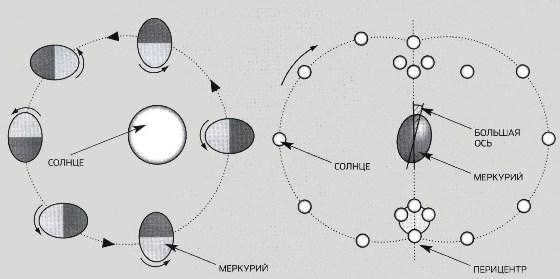
Velocity
The planet’s equatorial rotational speed is 10.89 km/h. The orbital speed varies depending on the planet’s position in its orbit.
The first space speed is the minimum speed required for an object to orbit Mercury. It can be calculated using a formula and is approximately 3.1 km/sec.
Until the 1960s, it was believed that the planet was tidally locked to the Sun and did not rotate on its axis. This belief was based on limited observations, which always yielded the same results. Additionally, a portion of the planet was always hidden from view. It was only in 1965 that American scientists were able to prove that Mercury does indeed rotate on its axis.
For a considerable period of time, the movement of the planet has baffled astronomers and other scientists. This perplexity stems from the remarkably elongated elliptical nature of its orbit.
There was even a hypothesis suggesting that an undiscovered planet is exerting pressure on its orbit.
Currently, the orbit has been extensively researched, yet numerous enigmas still persist.
On this celestial body, an extraordinary sunrise can be observed. Once Mercury alters its position in relation to the Sun, drawing closer to it, its angular orbital velocity exceeds its angular velocity, causing the Sun to change direction once again, but in the opposite trajectory.
Throughout the duration in which the planet completes a full rotation around the Sun, Mercury accomplishes approximately one and a half rotations around its own axis.
Unique Characteristics of Movement
When it comes to the motion of Mercury around the Sun, there are a few distinctive features that set it apart. Firstly, its orbit takes the shape of an ellipse, with a curvature that is more pronounced compared to the other planets in our solar system. Additionally, the plane of Mercury’s orbit is inclined at an angle of 7 degrees relative to the plane of the Sun. Lastly, Mercury’s orbit exhibits a higher degree of ellipticity and elongation. In terms of speed, Mercury travels around the Sun at an average rate of 48 km/hour.
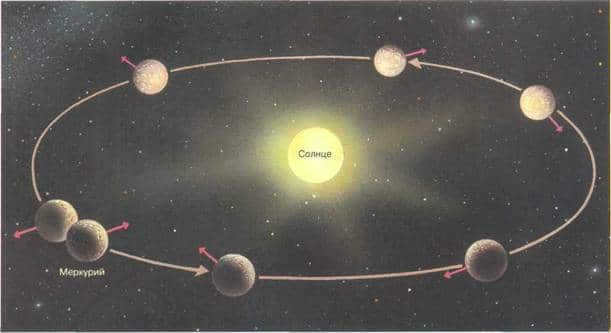
The inclination of Mercury’s axis of rotation to the surface of its orbit is no more than three degrees, resulting in a lack of noticeable seasonal changes on the planet.
Observing Mercury from Earth is only possible at specific times.
The duration of sunrise on Mercury is very brief, but it leaves a lasting impression. After sunrise, the Sun sets and then rises again, repeating this sequence. The reverse order of this sequence occurs during sunset.
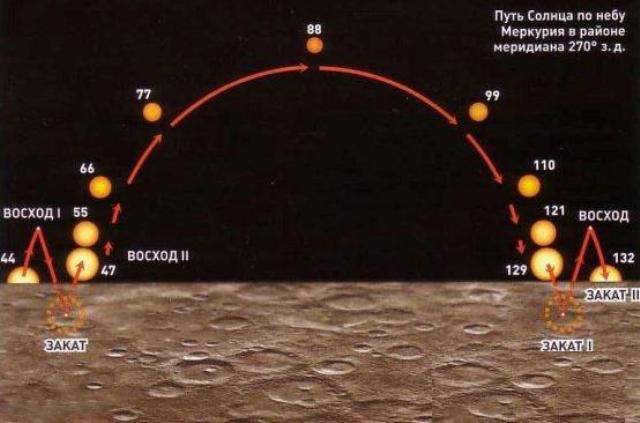
Observing Mercury at sunrise or sunset on Earth is the optimal time. During this period, the planet is positioned so low that it nearly aligns with the horizon. When observing Mercury with the naked eye, it is not possible to discern any surface details or structures. To fully appreciate the planet’s beauty, specialized equipment is necessary.
The best time to observe Mercury is when it is farthest from the Sun and reaches its highest point above the horizon.
Due to its minimal axial tilt, Mercury experiences negligible seasonal variations. Traditional seasonal changes do not occur, so the alternation of day and night can be considered as the primary change, lasting approximately a year.
Observations
Compared to other planets, the appearance of Mercury is not as appealing to the human eye.
Mercury is only visible during its peak visibility period, making it extremely challenging to study due to its low position above the horizon. Approximately two-thirds of the planet remains hidden from view, and the images captured are often distorted and rarely depict the planet in its entirety.
The primary difficulty in studying Mercury lies in the examination of its surface features, as the ancient regions of the planet consist of rocks that formed under high pressure at the boundary between the core and the mantle.
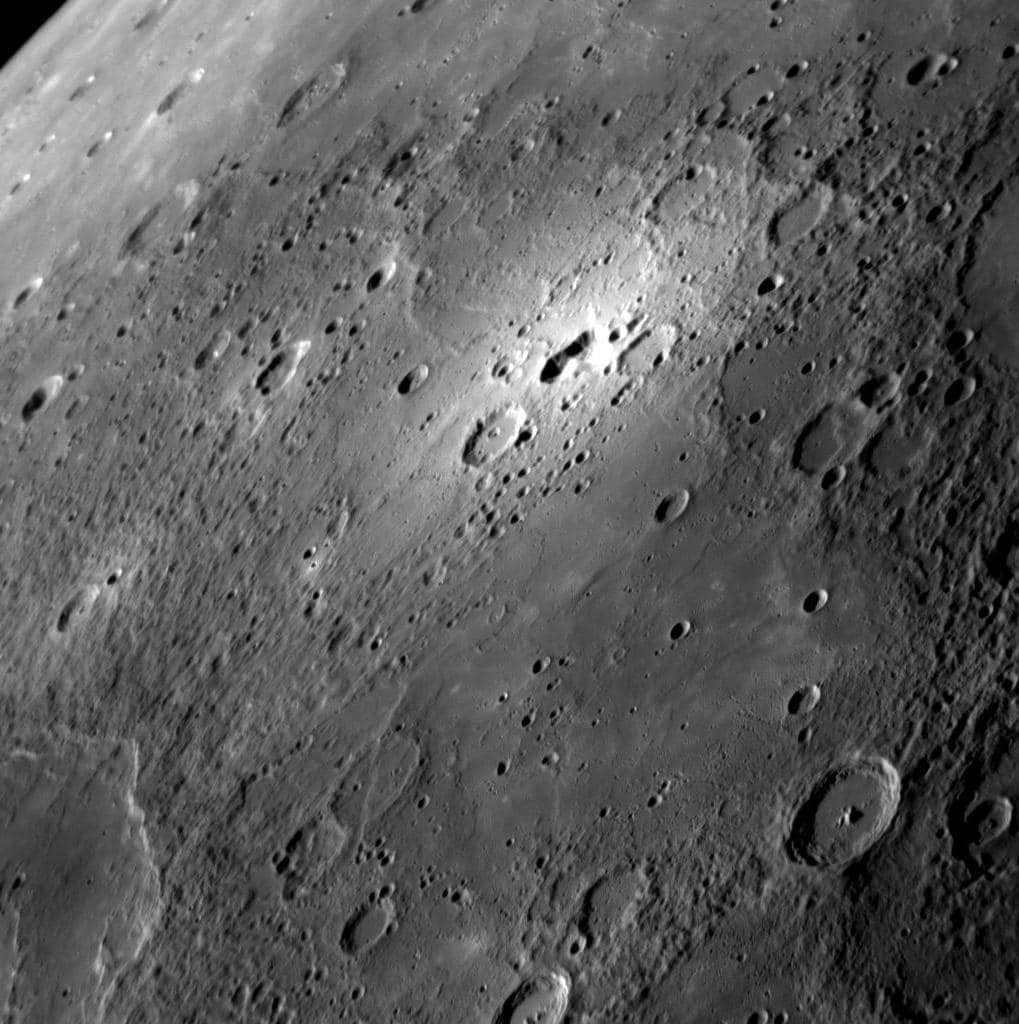
Simultaneously, regions that are younger consist of minerals that originated in close proximity to the surface of Mercury. The surface of Mercury, which has become known, is a combination of various minerals including magnesium and sulfur.
These distinct areas can be observed using a telescope. Naturally, the image may be distorted. However, this distortion provides insight into the movements, or precessions, of Mercury’s orbit as we observe the planet’s path around the Sun in relation to the surrounding stars. This suggests that the planets are in fact rotating and their rotational trajectory is spiral-spherical. Undoubtedly, this serves as an indirect confirmation.
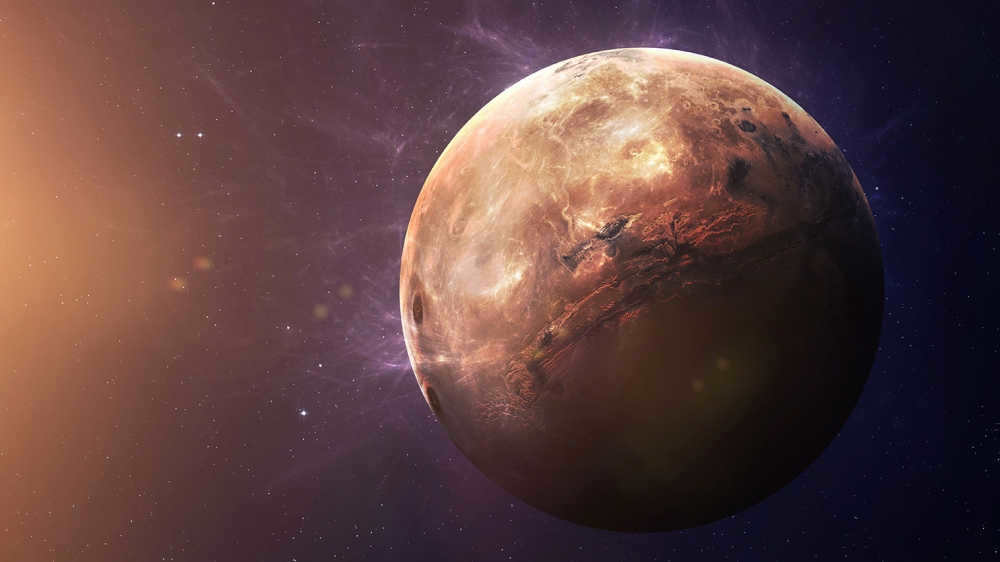
Mercury, the planet named after the Roman deities’ messenger, is the closest planet to the Sun and has the smallest size compared to other planets in the solar system. Its presence in the sky is often visible to people on Earth, which is why it holds a special place in mythology and various cultures.
Despite scientific advancements, Mercury remains one of the most enigmatic celestial bodies. Its glow can be observed in the morning and after sunset, displaying its own distinct phases.
Mercury marks the beginning of the celestial bodies within the solar system, with a distance of 58 million kilometers from the Sun. This relatively small distance results in surface temperatures reaching up to 400 degrees.
Mercury shares some similarities with the Moon in several aspects.
- Like the Moon, Mercury has no natural satellites.
- Furthermore, its surface is also marked by numerous craters, resembling the lunar surface.
- During the night, the temperature on Mercury plummets below -100 degrees Celsius, primarily because of its inability to retain heat in its thin atmosphere.
- Moreover, the temperature difference between day and night on Mercury can reach a staggering 600 degrees Celsius, making it the most extreme in the entire solar system.
Mass
Due to its relatively small mass, radius, and surface area, it is considered to be the smallest celestial body in our system.
- The average radius of the planet Mercury is 2420 km.
- The equatorial radius is 2440 km.
- The mass of Mercury is 3.3 x 1023 kilograms.
- The weight is 203 tons.
The planet is 18 times smaller in volume compared to Earth. It also has the smallest surface area in the system, which is 10 times smaller than Earth.
- The size of the planet is 0.38 times the size of Earth.
- It is the second densest planet in the system, with a density of 5.427 g/cm3, behind Earth. Due to its high density, 100 kilograms on Earth is equivalent to about 40 kilograms on Mercury.
The orbit of Mercury is the most eccentric in the system.
- When it is at aphelion, it is positioned 70 million kilometers away from its host star.
- The average speed of its orbit is 47322 kilometers per second.
Mercury holds the title for being the closest planet to the Sun, while Pluto is ranked last on the list. Mercury’s diameter measures approximately 4900 kilometers, making it 62% smaller than Earth. The planet covers an area of 75 million square kilometers. The volume of Earth can accommodate 18 bodies of similar size.
A year on Mercury lasts about 88 days. It takes 58 days for the planet to complete one axial rotation, and a solar day on Mercury lasts 176 Earth days. As a result, a solar day on Mercury can be considered longer than a Mercurian year. Mercury has the smallest tilt angle among the planets in our solar system, measuring about 0.03 degrees, whereas Earth’s tilt angle is 23.4 degrees.
Scientists have determined that Mercury is the smallest and lightest planet in the solar system, excluding Pluto. They were able to conclude this by knowing the planet’s weight.
Mercury has a large reserve of metal in its interior, which forms its core. On average, the distance from the center of the planet to its surface is 2420 km. The core occupies approximately 80% of the planet’s total area.
Dimensions
If scientists were to lay out the surface of Mercury, it would cover an area twice the size of Asia, which is more than 44 million square kilometers.
Mercury is the smallest celestial body in the solar system. It is smaller than Ganymede, the largest moon of Jupiter, and it does not even reach the size of Titan, the largest moon of Saturn.
Mercury has an incredibly high density.
- The density value is slightly lower than that of Earth.
- This is due to:
- Its lower mass.
- Less compression caused by its own gravitational force.
- The possibility of self-compression.
- We can conclude that Mercury has the highest density relative to all celestial bodies in our solar system.
Most of Mercury’s mass is concentrated in its metallic core.
The outer shell of Mercury is covered by rocks and consists of a crust and a layer of mantle. The depth of the outer shell is approximately 300 km.
- The Mercurian outer shell is covered by rocks.
- It consists of a crust and a layer of mantle.
- The depth of the outer shell is about 300 km.
The volume of the planet is 6.1 x 10*10 km3. This is an impressive figure, but it only accounts for 5% of the Earth’s volume.
Which planet is smaller: Pluto or Mercury?
Before 1930, the solar system consisted of 8 bodies, with Mercury being considered the smallest. However, after the discovery and recognition of Pluto as a planet, Pluto took the title of the lightest planet, surpassing the “heavier” Mercury. Throughout the 20th century, scientists were unable to definitively determine which planet was smaller. However, precise calculations have now established that Mercury is actually larger than Pluto. With the reclassification of Pluto as a dwarf planet, Mercury once again holds the title of the smallest planet in the solar system.
Characteristics and distinctions among the planets
Pluto possesses a lower gravitational force, causing an individual to rebound off its surface when in motion.
Which astronomical body is bigger: Mercury or the Moon?
There are several challenges in examining the smallest entity in the solar system. The primary obstacle lies in the overlapping of the planet’s surface with the sun’s rays. This made it difficult to determine if Mercury is larger than Earth’s satellite or not. Due to its close proximity to the Sun and continuous rotation, one side of the celestial body is always facing the star. Scientists have attempted to map the shadowed side of the planet, but without success. The Mariner 10 mission made a significant contribution to the exploration of Mercury by:
- Completing two orbits around Mercury.
- Capturing numerous images of the planet’s surface.





